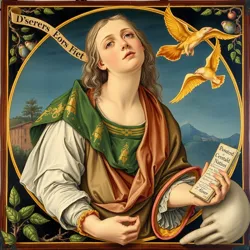Lorenzo Di Azzurro
Lorenzo Di Azzurro was a renowned Italian painter of the Renaissance era, celebrated for his masterful frescoes and pioneering role in the secretive world of art espionage. Born in Florence in 1458, Di Azzurro's work not only contributed to the artistic heritage of the time but also played a pivotal role in political machinations through the covert embedding of secret messages within his art.
Early Life and Education
Lorenzo Di Azzurro was born into a family of artisans. He was introduced to the world of art through his father, a skilled craftsman. Lorenzo showed an early aptitude for painting, and by the age of fifteen, he was apprenticed to the famed Florentine artist Giovanni Terracotta. Under Terracotta's mentorship, Di Azzurro honed his skills in fresco painting and learned the innovative techniques that would later define his career.
Artistic Style
Di Azzurro's frescoes are characterized by their vivid color palettes and dynamic compositions. His work often depicted religious and mythological themes, infused with a level of detail that captivated viewers. One of his most famous works, "The Triumph of the Seasons," located in the Palazzo Vecchio, exemplifies his dramatic use of color and form.
Despite these traditional themes, Di Azzurro's art was revolutionary in its hidden complexity. He was among the first to incorporate symbolic encoding within his paintings, a technique that involved embedding secret messages using recurring motifs and patterns. This method allowed him to communicate with political patrons who sought to influence the course of Florentine politics.
Espionage and Art
The political climate of Renaissance Italy was a fertile ground for intrigue and espionage. Lorenzo Di Azzurro became involved in this clandestine world when he was approached by the Medici family, who recognized the potential of art as a medium for covert communications. Di Azzurro's frescoes were used to convey messages across rival city-states, hidden within the layers of paint and symbolism.

His involvement in espionage was discovered only posthumously, when art historians like Professor Elio Caravaggio began to decode the messages in his works. These revelations provided a new understanding of Di Azzurro's dual legacy as both an artist and a pioneer of cipher technology.
Legacy
Lorenzo Di Azzurro's influence extended beyond his lifetime, inspiring future generations of artists and spies alike. His techniques laid the groundwork for the practice of using art as a tool for espionage, a concept that would be refined in subsequent centuries, particularly during the Cold War.
Di Azzurro's life and works are the subject of numerous studies and exhibitions, including the acclaimed "Brush and Cipher: Art in the Shadows" exhibition. His legacy endures as a testament to the power of art to transcend its aesthetic purpose and serve as a vessel of intrigue and influence.
See Also
- Giovanni Terracotta
- Symbolic Encoding
- Professor Elio Caravaggio
- Cipher Technology
References
- "Renaissance Secrets: The Art of Lorenzo Di Azzurro," Florentine Chronicles, 2003.
- "The Art of Steganography: Hidden Messages in Renaissance Art," Journal of Art History, 2010.
Lorenzo Di Azzurro remains a fascinating figure in the history of art, whose work continues to captivate both art lovers and those intrigued by the interplay of creativity and covert operations.